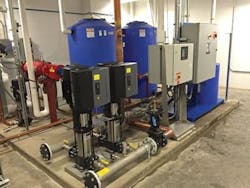Commercial Water: Environmental & Economic
The popularity of rainwater harvesting continues to increase in the wake of unparalleled drought in the West and Southwest. In some areas, like the District of Columbia, its use also has increased to meet regulatory requirements.
District Challenges
More than a billion gallons of storm water and sewage flow into the District of Columbia’s rivers every year. There are approximately 600 miles of sewer pipe in the District, and according to the District of Columbia Water and Sewer Authority, more than 34 miles of rivers and streams in and around the District do not support swimming or aquatic life.
The District’s combined sewers typically are not problematic in dry weather, but when the system becomes overwhelmed during rain events, a combination of storm water and sewage gets pushed out through a series of 53 drainage points. Ultimately, that delectable combination ends up in the Anacostia and Potomac rivers, and occasionally in Rock Creek.
Storm water runoff from separated and combined sewers is a principal source of the pathogens, chemicals and heavy metals (like cadmium, lead, zinc and phosphorus) that can damage local waterways and wildlife.
District Solution
The D.C. Water and Sewer Authority’s 20-year, $2.6 billion D.C. Clean Rivers Project will redirect approximately 2 billion gal of storm water overflow per year to the Blue Plains Advanced Water Treatment Plant through a 13-mile underground tunnel.
Beyond that, the District of Columbia’s Department of Energy & Environment has implemented programs that seek to reduce the storm water runoff that harms District waterways and Chesapeake Bay. One such program, RiverSmart, provides financial incentives to install green infrastructure that allows rainwater to remain on site for reuse and/or a slower return to the sewer through the use of a fixed-flow valve. Typical uses for treated rainwater include cooling tower makeup, flushing toilets, irrigation and other non-potable applications.
Collegiate Innovator
Recognizing the benefits of rainwater harvesting while also pursuing LEED Gold certification, George Washington University (GW) in Washington, D.C., opted to install a custom-designed system in its new, state-of-the-art 700,000-sq-ft Science and Engineering Hall.
As the largest academic building dedicated to science and engineering in the nation’s capital, the goal of this modern research hub is to inspire a new generation of faculty, researchers and students with its wet and dry laboratories, collaborative teaching areas and convening spaces.
A three-story-high bay also was built for large-scale experiments, in addition to facilities for imaging and nanotechnology fabrication. Eight of the building’s floors are above grade, and six are below grade—two for programming and four for parking.
“GW supports efforts to reduce rainwater runoff in the District, and the rainwater harvesting system in our Science and Engineering Hall is one example of how GW is contributing to improving our local ecosystem,” said Meghan Chapple, director of the GW Office of Sustainability.
A Simple Process
Rainwater is collected from the Science and Engineering Hall’s roof, then flows into a 42,000-gal cistern. It is prefiltered to remove large debris before being pumped into two underground day tanks. When the tank levels are low and they call for more water, recirculating water is sent into them. The water from the day tanks is sent through a bag filter for treatment and dyed before being sent off for reuse in the Science and Engineering Hall’s water closets, which typically use 1 gal of water for each flush.
GW opted to install an Aquanomix rainwater harvesting system for the building. The system’s controls seamlessly integrate with the building management system, continuously collecting qualitative and quantitative data, including water quality parameters (water sub-metering, pH, oxidation-reduction potential and conductivity).
It also incorporates real-time weather data from the National Weather Service to predict weather events for rainwater collection. All of these data are viewable 24/7 via a tablet or other Web-enabled device.
The Reward
The rainwater harvesting system helps GW save approximately 850,000 gal of water per year, providing cost savings as the rainwater takes the place of purchased city water. It also protects and preserves the capital assets installed downstream of the system, including the chiller plant equipment, plumbing fixtures and irrigation systems.
On a larger scale, harvesting rainwater reduces the energy and chemicals needed to treat storm water in the District’s wastewater treatment plants. It also reduces the volume and peak flow of storm water entering the sewer, thereby reducing flooding and combined sewer discharge—the whole reason behind the D.C. Clean Rivers Project.
Rainwater harvesting also reduces the volume of potable water used for non-potable applications, such as irrigation or toilet flushing. The District of Columbia’s drinking water source is the Potomac River, with an intake upstream of the District.
“Once you witness the successful installation and function of a rainwater reuse system, it becomes obvious that flushing toilets with drinking water is an antiquated process,” said Elias Mullane, managing partner and head of operations for Aquanomix. “It brings great satisfaction to a community when businesses support water conservation by repurposing rainwater [for] water closets, irrigation, fountains and more.”
Green Is Good
Through the installation of the rainwater harvesting system for the Science and Engineering Hall, GW is proving it is committed to the safety of the waters surrounding the District of Columbia, and it is economically and environmentally paving the way for other institutions to follow. Rainwater harvesting and sustainability are more than environmental gestures—they make long-term economic sense.
Download: Here
